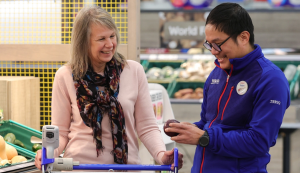The cost-of-living crisis has not derailed the Tesco train which continued to steam ahead over the past year when the supermarket profits more than doubled.
The grocer’s market share grew as it attracted shoppers from rivals across the board, however most notably, Tesco has seen 19 consecutive periods of net switching gains from the premium retailers.
We take a look at how innovation, range expansion and changing consumer behaviour is helping to drive the switch, and how Tesco fares against its supermarket rivals.

Tesco CEO Ken Murphy says that while Tesco hadn’t previously been “winning premium business from premium retailers, we’ve been doing it now for more than 12 months.”
GlobalData senior retail analyst Eleanor Simpson-Gould says that one of the factors for why these shoppers may be switching is because “Tesco has revamped its higher price point and third-party offers, launching new products into its well-performing Finest range”.
Over the year, the supermarket has launched over 1,000 new products and improved around 2,700 existing lines.
Murphy says that “customer perception of the quality of our products is growing ahead of the market”, as sales of its Finest range now exceed £2bn, up 15.7% during the year. Volumes of the range are up 9% and more than 23m customers have bought into the brand.
He explains that aside from its premium own-label offering, one of the biggest drivers in attracting customers from premium rivals was due to “the intrinsic quality” of its fresh foods, vegetables, meat, fish and poultry products.
He adds that changing consumer shopping habits over the last two years have also influenced the shift.
“Customers are responding when they see a new product or a high quality proposition and great value, that is definitely influencing them.”
“I do think there is a little bit more now a habit of eating in and entertaining in and then treating yourself, so that has been one of the drivers of our premium proposition growth,” says Murphy.
Simpson-Gould adds that for customers of premium grocers, Tesco’s Clubcard loyalty scheme and “extensive” home delivery capability “adds another dimension to its heightened appeal over discounters”.

While Tesco has been successful in gaining shoppers through growth in the premium market, Murphy points out that the retailer has won shoppers across the board.
Over the year, the supermarket experienced overall gains in both value and volume share in the UK with value up 28 basis points and volume up 8 basis points. This has in part been driven by 12 consecutive periods of switching gains.
Murphy says: “We’re not really focused on any one retailer. We’re focused on winning with customers and what I’m really pleased about is the fact that we appeal to an incredibly broad section of customers.”
He explains that Tesco prides itself as “a business on having something for everyone no matter your wallet”.
“We’re very pleased that we’re able to offer great value products at really keen prices and we’re really pleased that we can offer premium products that cost a little bit more. But our ambition is to make them accessible to everybody and that’s what we’re going to continue to do.”

Pre-tax profit for the full year to 24 February skyrocketed 159.5% to £2.3bn and group sales jumped 7.4% to £61.4bn as Murphy claims this is “the most competitive” Tesco has ever been in terms of value.
However, Simpson-Gould says that “with inflationary pressure easing, we expect to see a normalisation of sales growth in Tesco’s new financial year, which will bring new challenges for the grocer to remain competitive on price.”
She adds that key priorities for Tesco in the next financial year should be “passing on cost savings to customers to keep the pressure on competitors and drive volume growth”.
“Tesco must continue to innovate and expand its Finest range and third-party offers to compete with premium players as Mother’s Day and Valentine’s Day events this year have seen a growth in consumers opting to celebrate with a meal at home.
“Events at home will be a core area that Tesco must capitalise on, with more choice of dine-in options as Father’s Day and summer approach.”
Murphy acknowledges that “one of the characteristics of anybody in grocery retail is a healthy dose of paranoia because we’re in such an intensely competitive environment,” adding that Tesco does experience “threats from all sorts of angles”.
“Aldi and Lidl have twice the number of stores now that they had 10 years ago and we’ve seen a bit of a resurgence in Morrisons since its brought a new leader on board so it’s never standing still and I’m sure we will see Asda make a comeback as all the other competitors remain fiercely competitive.”
Despite this, he adds that Tesco is “feeling really good about where we are at”.
“The fact that are 11 national grocers all competing for share means that someone is always coming in strong and there are ebbs and flows in the market. I think the key for us is around consistency.
“Consistently the best value, consistently the best quality, consistently the best shopping trip, that’s really where we’re placing our focus. If we get that right, we think we can win in any environment.”
Tesco’s investments into value paired with the expansion and innovation of its product ranges has ultimately helped it to be more widely recognised as a destination for more than just your everyday grocery shop.
With a keen focus on consistency in the year ahead, Tesco will hope to welcome new shoppers from across the board.